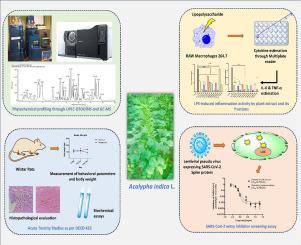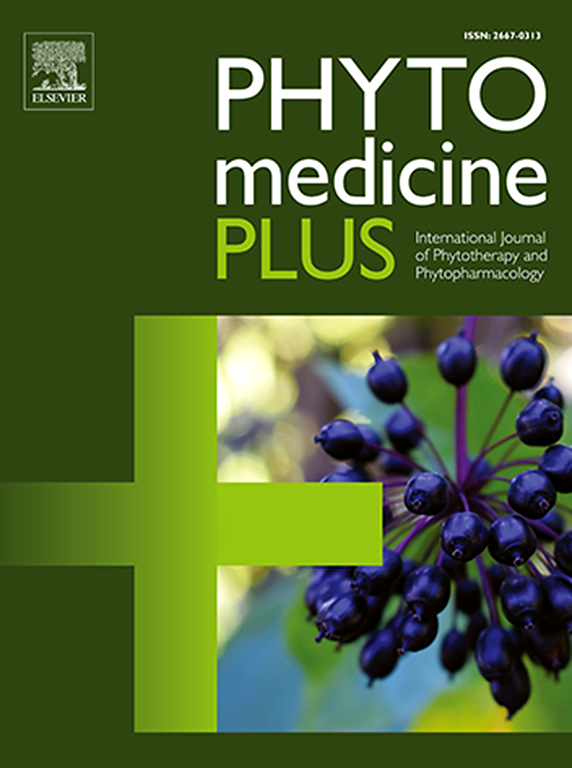通过调节NF-κB通路评价白果多糖对巨噬细胞的抗病毒和抗炎活性
Q3 Pharmacology, Toxicology and Pharmaceutics
引用次数: 0
摘要
炎症在SARS-CoV-2感染的严重程度中起着重要作用,因为过度的免疫反应会导致组织损伤和严重的呼吸窘迫。具有抗炎和免疫调节特性的植物化学物质可能有助于控制这些影响。仙人掌,大戟科一年生草本植物,传统上用于治疗呼吸系统疾病。目的研究籼稻的植物化学特征及其抗炎和抗sars - cov -2的双重活性。目前的研究提供了一种有针对性的方法来预防SARS-CoV-2感染和相关的炎症,使用化学特征纯化的部分。方法采用hplc - qtof - ms和GC-MS进行植物化学分析。采用酶联免疫吸附试验(ELISA)测定细胞因子和抑制假病毒进入试验,分别评价其体外抗炎活性和抗sars - cov -2活性。此外,根据经合组织第425号准则对急性毒性进行了评估,以确保提取物用于治疗的安全性。结果鉴定出的主要化合物分别为没食子酸、山奈酚、芦丁、萼花苷、叶绿醇、豆甾醇、β-谷甾醇,分别来自酚类、黄酮类、氰苷类、无环二萜醇类和甾醇类。牛蒡粗提物和提取物可降低脂多糖(LPS)诱导的TNF-α和IL-6的产生。值得注意的是,与LPS相比,己烷可溶性部分表现出最强的活性,降低了8 - 9倍。表达SARS-CoV-2刺突的假病毒实验表明,己烷可溶性部分限制了表达SARS-CoV-2刺突糖蛋白的假病毒颗粒的进入,IC50值为739 μg/mL。结论荆芥提取物具有抗炎和抗sars - cov -2的作用,提示其具有治疗炎症相关病毒感染的潜力。本文章由计算机程序翻译,如有差异,请以英文原文为准。

Evaluation of the antiviral and anti-inflammatory activity of Acalypha indica L. in LPS-induced macrophages via modulating NF-κB pathway
Background
Inflammation plays a major role in SARS-CoV-2 infection severity, as an excessive immune response can cause tissue damage and severe respiratory distress. Phytochemicals, with their anti-inflammatory and immune-regulating properties, offer the potential in helping to manage these effects. Acalypha indica, an annual herb from the Euphorbiaceae family, is traditionally used to treat respiratory issues.
Purpose
The study aims to assess the phytochemical profile and dual anti-inflammatory and anti-SARS-CoV-2 activity of A. indica. The current study offers a targeted approach to prevent SARS-CoV-2 infection and associated inflammatory conditions using a chemically characterized purified fraction.
Methods
UPLC-QTOF-MS and GC–MS were used for phytochemical profiling. The in vitro anti-inflammatory activity and anti-SARS-CoV-2 activity were assessed using ELISA cytokine estimation and pseudovirus entry inhibition assay, respectively. Additionally, acute toxicity was evaluated following OECD guidelines 425, which ensures the safety of the extract for its therapeutic use.
Results
The major compounds identified are gallic acid, kaempferol, rutin, acalyphin, phytol, stigmasterol, β-sitosterol from the group of phenolics, flavonoids, cyanogenic glycosides, acyclic diterpene alcohol, and sterols, respectively. The crude extract and fractions of A. indica reduced the production of lipopolysaccharide (LPS) induced TNF-α and IL-6. Notably, the hexane-soluble fraction demonstrated the strongest activity, an 8–9-fold reduction compared to LPS only. The pseudovirus expressing SARS-CoV-2 Spike assay displayed that the hexane-soluble fraction restricted the entry of pseudovirus particles expressing SARS-CoV-2 Spike glycoprotein, with an IC50 value of 739 μg/mL.
Conclusion
Acalypha indica extract shows anti-inflammatory and anti-SARS-CoV-2 properties, suggesting its potential for treating inflammation-related viral infections.
求助全文
通过发布文献求助,成功后即可免费获取论文全文。
去求助
来源期刊

Phytomedicine Plus
Medicine-Complementary and Alternative Medicine
CiteScore
3.70
自引率
0.00%
发文量
178
审稿时长
81 days
期刊介绍:
 求助内容:
求助内容: 应助结果提醒方式:
应助结果提醒方式:


